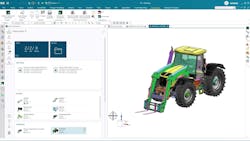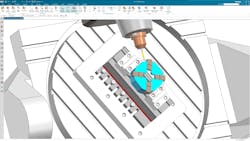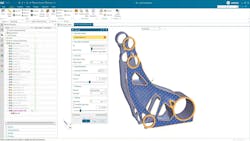NX CAD Enhancements Boost Collaborative Design to the Cloud
Siemens Digital Industries Software has rolled out enhancements to its flagship product engineering software.
Siemens NX X is a secure cloud software-as-a-service infrastructure that takes traditional NX to the cloud with the addition of built-in data management based on the Teamcenter portfolio for Product Lifecycle Management (PLM).
During a sit-down interview with Machine Design at Siemens’ digital transformation conference and user event earlier this year, Jeffery Miller, product marketing director, Siemens Digital Industries Software, said NX X is still deployed on the desktop as a desktop application, except the installation, deployment and user management are cloud-based.
“NX X is the same NX that our users know and love from a product to functional perspective, capability perspective,” said Miller.
Cloud-Based Version of NX
Miller characterized NX as one of the most powerful CAD products on the market. “We can cover literally every aspect of design,” he said. “Everything from upfront styling and design, all the way through to 3D modeling. We can get into generative engineering now...The beauty of that is it’s all integrated within one single application.”
The product engineering software enhances native collaboration functionality, flexibility and shaves time off IT administration. The deployment enables browser streaming via Amazon Web Services (AWS). PLM capabilities with secure data management for seamless collaboration are facilitated via Teamcenter X software.
Same, Same, But Different: 110 Products and Capability Extensions
As a complete design-to-manufacturing suite, NX is known for the breadth and depth the solution offers in product design, engineering and manufacturing. The suite provides advanced tools for 3D modeling, drafting and simulation. The software is used across industries, from aerospace and automotive to machinery and consumer products.
“NX stands out in multidiscipline design,” said Miller. “Designing products is not just about the individual part or the assembly. And it’s not all mechanical anymore, either. You look at any products developed today. I’ve seen umbrellas with Bluetooth modules in them. Everything has got some form of electronic or some form of electrical aspect. So, you need a multidisciplinary tool that covers not only the mechanical side, but the integration with electrical, the integration with electronic, integrations into the simulation, and now even integration into software and software-driven design."
READ MORE: Design Engineering: View CAD from a Different Angle
Siemens noted in a press release that NX X offers flexible and scalable licensing configured to be adaptable and cost-effective. By extension, this enables small, medium and large enterprises to access NX add-on modules and advanced NX capabilities. There are more than 110 products and capability extensions available.
For example, the AI-driven NX optional add-on module, which can be purchased through the value-based licensing pool. Design engineers may tap into Performance Predictor, an AI-enabled design simulation tool for validating material choices and mechanical performance of individual parts in real time.
The new cloud arrangement allows access to AI-enabled topology optimization and new gyroid lattice and infill design capabilities, as well as the Design Space Explorer capability introduced in 2023, so that designers can create optimal parts, conduct light weighting studies and make the most of additive manufacturing techniques.
NX X also works alongside Siemens’ newly announced Zel X software, a browser-based engineering app that integrates with other Siemens Xcelerator solutions for streamlining manufacturing and shop-floor operations.
Maintaining Relevance Relative to Competitors
According to Miller, proof of success is in the number of customers who can be successful when using the product. “I look at the number of accounts and the number of companies that we have out there, that are designing products and being successful with those products, bringing their products to market as quickly and rapidly as possible,” he said. “Many of the top OEMs, across many different industries are using NX.”
Still, “it’s “not just NX in itself,” pointed out Miller. The product’s effectiveness is bolstered when used in relation to the overall Siemens Xcelerator portfolio. Integration then extends into other areas of the organization, including the Teamcenter portfolio for Product Lifecycle Management (PLM) and Simcenter X for modeling and post-processing.
All these linkages support a fully integrated solution, which drives customers’ success, Miller explained. “Nobody else can really do that the way that we can do it,” he said.
Use Case: Roadside Assistance for Satellites
Space Machines Company (SMC) is an Australian space on-orbit services and logistics startup that used Siemens Xcelerator portfolio to design and build the Optimus Orbital Servicing Vehicle. Not only is Optimus the first orbital service vehicle (OSV), but Optimus also is one of the largest commercial spacecrafts being designed, manufactured and assembled in Australia.
Siemens noted in a press release that SMC used NX software for design and modeling, Simcenter software for thermo-mechanical elements simulation and analyses and Teamcenter X software as a service (SaaS) for cloud-based Product Lifecycle Management (PLM).
READ MORE: Bringing CAE Reporting into the Digital Era
The 270 kg (about 595.25 lb) Optimus will be launched by a SpaceX rocket from the United States to help taxi commercial satellites into their orbital paths around Earth and beyond. Optimus’ main purpose will be to service, maintain, repair and extend the life of other satellites in orbit.
"On-orbit servicing and logistics is the new frontier in space innovation,” said Rajat Kulshrestha, CEO, Space Machines Company. “Many critical aspects of our daily lives, such as banking, weather forecasting and global communications are impacted by the ability of satellites to deliver these critical services. There are over 7,000 active satellites orbiting Earth. These satellites, and new ones coming into orbit, need a sustainable and safe operating environment.”
NX CAM and NX AM Workflow Productivity Updates
Upgrades targeting speed and control for part manufacturing have also been made to NX CAM and NX Additive Manufacturing (AM).
Siemens stated that enhanced 3D Adaptive Roughing, a high-speed machining strategy, “helps programmers to automatically specify start locations, resulting in more efficient machining and longer tool life.”
Other feature enhancements that Siemens listed are:
- The hole-making operation has been improved to provide finer control over tool moves that ensures safe machining and enhanced surface quality.
- Cloud Connect Tool Manager has been upgraded to streamline CNC programming. For faster programming, direct access to tool vendor catalogs now enables association of machining settings with cutting tools.
- Workflows for preparing additive manufacturing build jobs for metal and polymer parts have been streamlined with new enhancements. New facet selection methods simplify the creation of support structures for parts modeled with facet geometry.
- New capabilities for subnesting, sinterbox creation, slice area distribution calculation and 3D packing optimization simplify and accelerate the workflow for preparing polymer builds jobs.
- Siemens build processors simplify the generation and output of print job files from NX to SLM Solutions and Trumpf metal 3D printers.
- New multi-axis additive build rules enable creation and reuse of custom process parameters, often considered to be the “secret sauce” for achieving consistent high-quality builds.
READ MORE: Automate 2024 Wrap-up: Shifting the Robotics Paradigm to Flexible, Agnostic Solutions
About the Author

Rehana Begg
Editor-in-Chief, Machine Design
As Machine Design’s content lead, Rehana Begg is tasked with elevating the voice of the design and multi-disciplinary engineer in the face of digital transformation and engineering innovation. Begg has more than 24 years of editorial experience and has spent the past decade in the trenches of industrial manufacturing, focusing on new technologies, manufacturing innovation and business. Her B2B career has taken her from corporate boardrooms to plant floors and underground mining stopes, covering everything from automation & IIoT, robotics, mechanical design and additive manufacturing to plant operations, maintenance, reliability and continuous improvement. Begg holds an MBA, a Master of Journalism degree, and a BA (Hons.) in Political Science. She is committed to lifelong learning and feeds her passion for innovation in publishing, transparent science and clear communication by attending relevant conferences and seminars/workshops.
Follow Rehana Begg via the following social media handles:
X: @rehanabegg
LinkedIn: @rehanabegg and @MachineDesign



